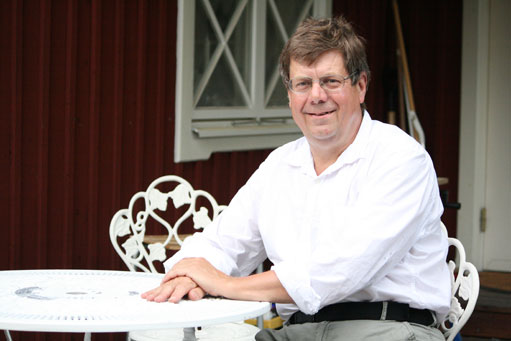Bengt Lund-Jensen
27 July 2010 | By

“In Sweden you can go out dancing in the summertime, where they play popular music but adapted for dancing,” says Stockholm native Bengt Lund-Jensen. Nine years ago, he decided to re-visit the dances of his undergrad days in pursuit of fitness, and now he spends his summers stepping out with other Scandinavians in the midnight twilight.
“It's a kind of swing dance, but it's not done in more than Sweden, Finland, and Norway,” he explains. “Most swing dance is six or eight counts, but this is four counts to the basic step.”
Already a master of Boogie Woogie and Lindy Hop, two years ago Bengt added this new dance, Balboa, to his repertoire. “It's danced to the same music as Jitterbug,” he says of the fast dance, which originated in the crowded ballrooms of 1930s west coast America. “It was forgotten for a long time, but some people have been taking it up again and now there's a Balboa community all over the world.”
This dancing community that Bengt can count himself a part of is not trivial. After a reception at the recent ATLAS Week in Copenhagen, he wandered to a local park on the off-chance and ended up dancing the night away with familiar faces, a fact which, while staggering to an outsider, leaves him absolutely un-phased: “I expected that some would be there,” he smiles. “Though I recognised more dancers than I thought.”
Some of these, he knew from the Herräng summer dance camp, a five-week long party which attracts dancers from all over the world to a tiny Swedish village. This year, he made his third trip to the camp, meandering down the coast on his IF sailing boat, Spinaway, to spend a week dancing with 1000 others who simply can't sit still.
Boats, too, are a way of life for Bengt, who lives just outside the city of Stockholm, in the stunning archipelago. “I absolutely love it as a place,” he beams. “If I bike for five minutes, I can take a boat into central Stockholm to go to work.”
The boats run from April to Christmas – until the water freezes and becomes impassable, forcing people into their cars – and the same motley crew of ten or fifteen regulars can be found there each morning and evening. “We sit and chat. You can drink a coffee. And they have Internet on the boat, so working is a possibility. You can finish off work in the evening, send the last few emails on the way home.“ It was a chance encounter on the boat that eventually led to Bengt's 17-year-old son, Malcolm, taking up the bagpipes six years ago.
The trade-off for these lovely social summers, of course, is the Scandinavian winters: “the worst time of the year”. The sun shows its face reluctantly between the hours of 9:00 a.m and 3:00 p.m. but once the snow falls in December, things start to turn magical. “Without any snow, it's dark, just plain dark. But with the snow,” Bengt considers, slowly, contemplatively, “it's… different. The tiny bit of light there is reflects back.”
Bengt's life is and always has been blissfully Stockholm-centric, but he tries hard to “jigsaw” family life, working in the tiny ATLAS group at the Royal Institute of Technology, Stockholm, and visits to CERN for meetings, discussions, and to fulfil his shift-duty to his detector.
“I spent a lot of my scientific life building this fantastic detector, and now we really need to make the very best of the data that we can,” he explains. “It's not just about doing your own analysis. That's the collaborative spirit.”
He has been involved with ATLAS since the very beginning, joining to work on preparations for LHC experiments as a post-doc with the Royal Institute of Technology in 1989, following a stint at CERN as an Uppsala University engineering physics PhD student from 1980 to 1985. Here, he fell in love with the place, the attitude of the people, the international style, and the scientific possibilities.
“It's a fantastic place for a PhD student to be,” he says. “There're so many people, a lot of scientific knowledge, and most are willing to give PhD students part of their time answering questions.”
On the subject of the 20-year LHC journey, he laughs: “If someone had told me in 1989 that we'd get data in 2010, I might have done something else in the meantime! But I think we learned a lot along the way about making a large experiment. And it was a very, very nice feeling to know that, after all these years, we've got data.”
Up until this point in his career, Bengt has been solely involved in detector design, preparation, construction, and testing (contributing to the ATLAS barrel presampler and optical read-out fibres for the Liquid Argon calorimeter). For the first time now, his attentions are turning to physics analysis. His eye is on Supersymmetry, and what it might tell us about Dark Matter and Dark Energy, but his mind is open.
“We don't know what nature is like for us. We're having to find out. I believe we'll find something, but what this something is, I don't know.”
In the meanwhile, expect Bengt to continue dancing to his own beat.



